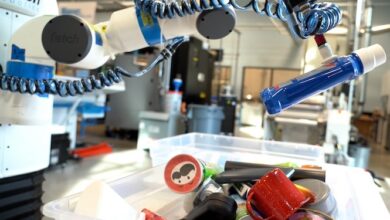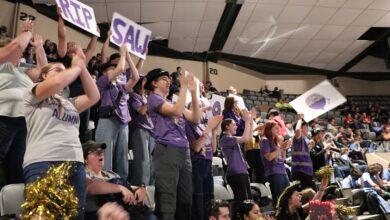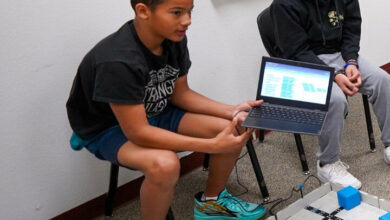Marine City Cardinal Mooney robotics team heads to world championships – The Voice
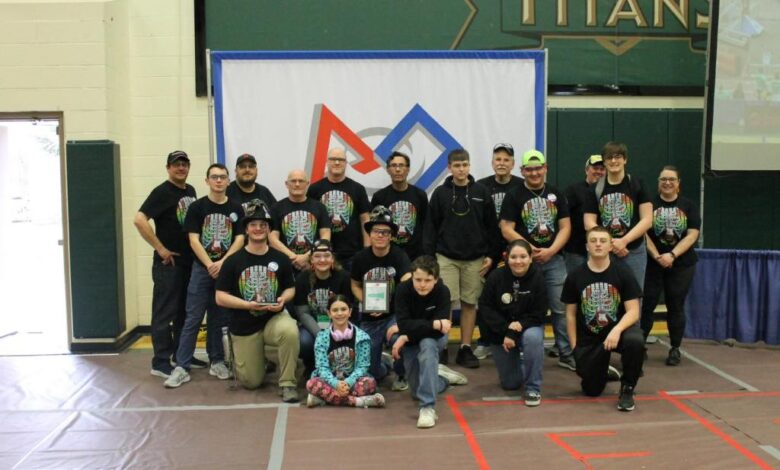
Cardinal Mooney Catholic High School’s FIRST Robotics Team 4779, the RoboSapiens, will participate in the 2024 FIRST Championship FIRST Robotics Competition from April 17 to 20. (Courtesy of FRC #4779 RoboSapiens/Facebook)
Cardinal Mooney Catholic High School’s FIRST Robotics Team 4779, the RoboSapiens, is headed to the 2024 FIRST Championship FIRST Robotics Competition.
Teams from around the world will compete in the event, which will run from April 17 to 20 in Houston, Texas.
The RoboSapiens are a part of the Blue Water Area Robotics Alliance, a consortium of 10 St. Clair County high schools headed by Steve Tenniswood. The team is one of two teams from the alliance going to the world championship, the other being the Richmond Blue Devils, Team 4130, led by John VanGampelaere.
The RoboSapiens is comprised of 12 high school students and one seventh grader, Alex Path, who is capable of contributing at the high school level.
“We have outstanding seniors leading the team — Ryan Miller, captain of the build team; Eddie Foster, captain of the programming team; Antonio Liberatore, drive team; Aiden Schocker, build team; William Wuerz, journalist extraordinaire, and Ben Green, all-around helper,” Lead Mentor Roy Miodonski said. “The future looks bright for this team, and these seniors certainly have helped lay a foundation for us to continue building on.”
Cara Ritchey will assume leadership of the build team when Miller graduates and Katrina Foster plays a pivotal role on the business team and will fill the shoes left by Wuerz, Miodonski said.
The remaining team members are Conor Guyor, who is the “human player” on the drive team; Sam “Bobo” Rzeszutek who will lead the programming team next year replacing Foster, and programmers Zander Somma and James Bostick.
Each year, a different game is played, so building of the robot cannot start until the game is announced, which occurred globally on Jan. 6 when the musically themed game “Crescendo” was unveiled, Miodonski said.
“Immediately, the team analyzed the game to determine a strategy for playing it, which in turn dictates the capability and design of the robot,” he said. “Wasting no time, the team then began ‘CAD-ing up’ ideas, creating ‘proof-of-concept’ models and prototypes before proceeding with the actual fabrication and assembly of the robot. In the meantime, the programming team is writing the code which will make the robot come to life.”
The robot then takes to the practice field in Port Huron, which is provided to BWARA by PJ Wallbanks Springs Inc., where it is tested, debugged and refined in order to make it competition ready.
Competitions begin at the start of March, and the RoboSapiens competed in two district competitions, with 40 schools attending each. The first was at Kettering University.
“After 80 rounds of qualifications, we were the overall no. 2 draft pick out of a field of 40 robots and finished the event in fourth place,” Miodonski said.
The second district event took place in Traverse City.
“All of the FIRST Robotics statistical websites and analysts were ranking us as the no. 1 overall performing bot heading into the event,” Miodonski said. “At the end of 80 qualification matches, we were ranked as the no. 1 overall team and we were the captain of the no. 1 seeded alliance going into the playoffs for the event, finishing third. The RoboSapiens were recognized in Traverse City by a panel of judges at the event with the ‘Autonomous Award.’ Only one team is awarded this per competition.”
“Getting this award for the second year in a row shows that we are pulling ahead of the field when it comes to the level and sophistication in our robot, software and sensors and how the students are learning how to integrate all of that together with a solid robot design,” he continued.
The team’s performance at the district events allowed it to go to the state championship at Saginaw Valley State University from April 4 to 6.
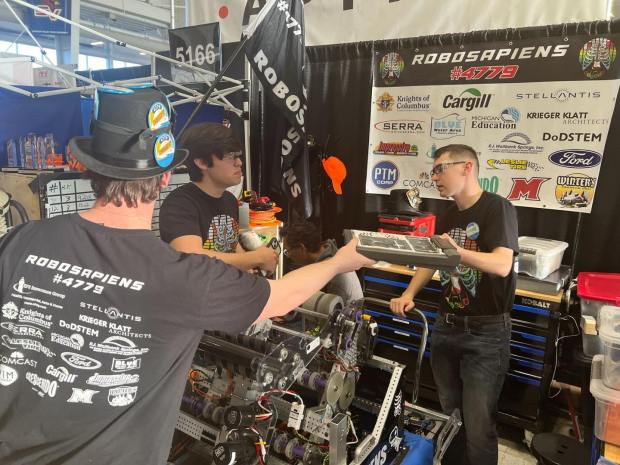
Miodonski said the team performed “exceptionally well” at the state competition, where 160 schools participated. The schools were broken up into four divisions of 40 teams each, playing on separate fields. The division winners then met in a four-team playoff to determine the state champion.
“The RoboSapiens made it to the finals in our division, the winner of which is determined by the best of three matches,” Miodonski said. “The opposing alliance won the first match. We won the second match, and they ultimately won the third. Had we won, we would have advanced to the ‘final four.’ But regardless, our performance earned us way more than enough points to qualify for worlds.”
“In fact, we finished ranked 26th in the state from over 500 schools,” he continued. “This is pretty amazing because FIRST Robotics does not break up that field by the size of population of the school or the team. Many of the teams ranked above us come from Class A or AA public schools. We have less than 200 students. This is the third year in a row we qualified for states, and the second year in a row that we are going to the world championship.”
The cost to attend the world championship is about $25,000, which covers the entry fee, lodging, food and travel costs, Miodonski said.
“We are currently short $10,000, which has been loaned to us to make the trip possible, but needs to be repaid upon our return,” he said. “Donations are greatly appreciated.”
Donations can be made at givecampus.com/schools/cardinalmooneycatholichighschool/cardinal-mooney-robotics.
“Robotics helps students in so many ways, starting with learning the ‘hard’ skills necessary to design, build, program and market the robot,” Miodonski said. “However, equally beneficial are the ‘soft’ skills, those which are less tangible but are useful lifelong skills regardless of the student’s career path, such as critical thinking, negotiation skills, decision making, working under pressure and time constraints, conflict resolution and the like. In fact, I believe the single greatest takeaway is confidence, because the students take ownership and are responsible for carrying out the program.”
“The size and scale of robotics is not something that can fully be appreciated until you witness the level of competition, the intensity of the students, the work that goes on in the pits in between matches and all of the organization, logistics and sponsorship that has to go on behind the scenes to make it all happen,” he continued.
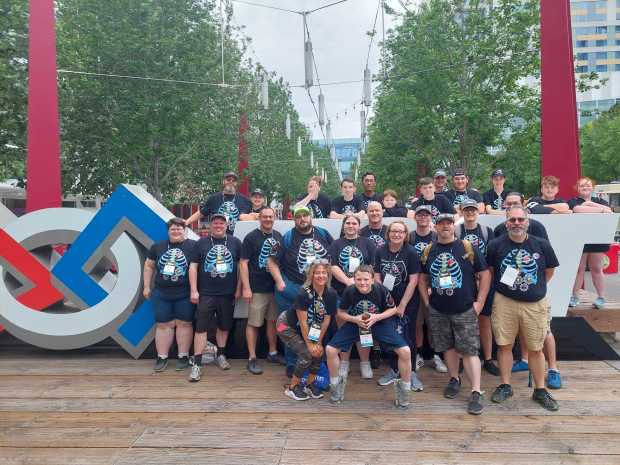
He said robotics helps students discover their passion and career desires, and that many students enter as freshmen not knowing what they want to pursue, but find what they like and end up studying things in college like engineering, computer science, and other STEM subjects which lead them to in-demand careers.
“RoboSapiens robotics students are actively recruited by colleges and have amassed over $500,000 in scholarships since the program’s inception,” he said.
Miodonski also said the “unsung heroes” in the robotics program are the mentors and parents who volunteer hundreds of hours to teach the students. The RoboSapiens have 10 mentors.
“Equally important are our sponsors who are the financial enablers who make the program possible as we are self-sustaining — that is, we raise all of the money necessary to operate the team,” he continued. “And finally, there is the Cardinal Mooney’s administration, who initiated the program years ago, help recruit incoming students to the program and in general support the team as needed.”
For more information, visit sites.google.com/view/robosapiens4779 or search for “FRC #4779 RoboSapiens” on Facebook.
View more on
The Voice
